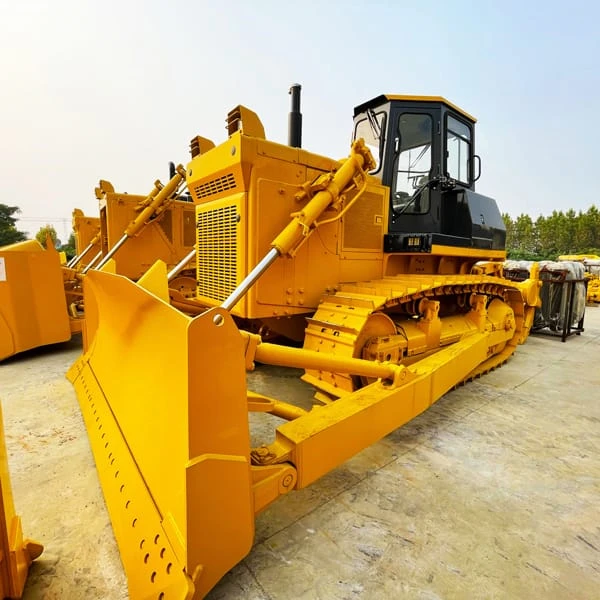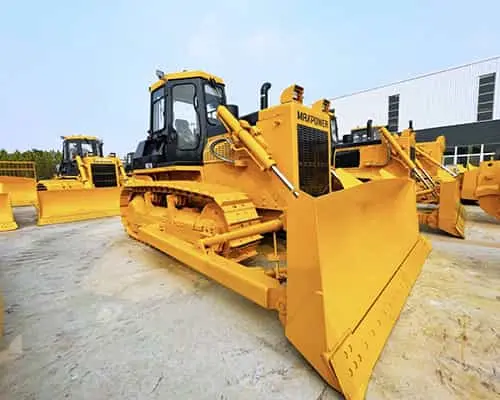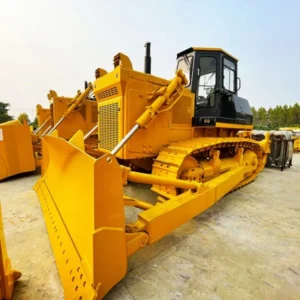Introducción
In this article, we delve into the “Meaning of Dozer,” exploring its various connotations and applications. A dozer, commonly referred to as a bulldozer, is a powerful piece of heavy machinery primarily used in construction, mining, and other industries requiring significant earth-moving capabilities. Here, we’ll dissect the functionalities, types, and significant uses of dozers, providing a comprehensive understanding of why they are indispensable in many fields.
What Is a Tractor topador?

In the realm of heavy machinery, a “dozer” typically refers to a bulldozer, a robust and powerful vehicle known for its substantial earth-moving capabilities. Central to its design is a large metal blade, which is used to push substantial quantities of soil, sand, rubble, or similar materials, making it an essential tool in various construction, mining, and road-building projects.
The term “dozer” itself is derived from the blade’s primary function—to “doze,” or push material. This vehicle is constructed on a durable, heavy chassis that provides the necessary stability for heavy-duty operations. The blade, which can be adjusted in height and angle, is mounted at the front of the dozer, allowing the operator to manipulate and move material as required.
Most dozers are equipped with tracks, similar to those on a tank, which distribute the heavy weight of the dozer over a large area, reducing ground pressure and enabling the machine to move across soft or muddy ground with more ease than wheeled vehicles. Some models, however, are equipped with wheels, which are better suited for hard, compact surfaces where speed and maneuverability are more critical.
Beyond the standard blade, many dozers are also equipped with a ripper on the rear, a tool that resembles a large claw. The ripper is used to break up hard surfaces like dried earth or pavement, making it easier for the blade to do its work in subsequent passes.
Dozers are powered by large diesel engines that provide the high power output necessary to move heavy materials. The operator controls the dozer from a cab situated above the engine, offering a comprehensive view of the work area. Modern dozers are equipped with advanced technology, including GPS mapping and automated controls, to enhance precision, efficiency, and safety.
Overall, the dozer is a versatile and indispensable piece of equipment in the heavy machinery industry, renowned for its ability to efficiently clear and prepare land across various challenging environments.
Key Components of a Tractor topador
A dozer, fundamentally a heavy-duty machine designed for pushing and leveling earth, comprises several key components that collectively enhance its efficiency and functionality in rugged environments. Understanding these components is essential for anyone involved in operating or maintaining this powerful equipment.
Cuchilla
The blade is the most recognizable part of a dozer and is responsible for its primary function: pushing and moving materials. Blades come in different shapes and sizes, each tailored to specific tasks:
- Straight Blade (S-blade): Best for fine grading; it is short and has no lateral curve, no side wings.
- Universal Blade (U-blade): Larger and curved with large side wings to carry more material, ideal for pushing, hauling, and containing more material across a site.
- Semi-U Blade: A combination of the straight and universal blades, offering a good balance of soil penetration and material retention.
Destripador
Located at the rear of the dozer, the ripper is used to break up hard surfaces and loosen compacted materials, making them easier to manage and move with the blade. Rippers can be single shank or multi-shank, with the choice depending on the depth and toughness of the material to be broken up.
Tren de aterrizaje
The undercarriage supports the weight of the dozer and provides traction that enables it to move across various terrains. It includes several components:
- Tracks: Typically made from heavy-duty steel, tracks distribute the dozer’s weight over a large area, decreasing ground pressure and allowing the machine to move on soft, unstable ground.
- Rollers and Idlers: These facilitate smooth movement of the tracks and are designed to withstand the harsh forces exerted during operation.
Motor
The engine is the powerhouse of the dozer, providing the necessary force to drive the machine and operate its mechanical parts. Most dozers are equipped with large diesel engines that deliver high torque at low speeds—crucial for the heavy lifting and pushing tasks they perform.
Cab
The cab is the control center for the dozer, from where the operator manages the machine. Modern cabs are designed with operator comfort and safety in mind, equipped with ergonomic controls, visibility-enhancing features, and sometimes even climate control systems. Advanced dozers may also include digital displays and systems for GPS and other operational technologies.
Hydraulic System
Dozers rely on hydraulic systems to move the blade and ripper. This system includes pumps, cylinders, and hydraulic fluid that help transfer power from the engine to the dozer’s working components, allowing for precise manipulation of the blade and ripper.
Each component of a dozer is critical to its operation and efficiency. Together, they make the dozer a versatile machine capable of performing in various heavy-duty tasks in construction, mining, and other industrial applications.
Tipos de Topadoras
Dozers are classified into various types based on their design, functionality, and the environments in which they are most effective. Each type of dozer has distinct features tailored to meet specific operational requirements. Here’s a closer look at the primary types of dozers used in the construction and mining industries:
Crawler Dozer
Crawler dozers, also known as track dozers, are characterized by their large tracks, similar to those of a tank. These tracks provide a larger surface area contact with the ground, which distributes the machine’s weight and enhances stability. This makes crawler dozers particularly effective on soft, slippery, or uneven terrains where wheels might sink or fail to provide sufficient grip. Due to their heavyweight and robust construction, crawler dozers excel in pushing large volumes of soil, sand, rubble, and other debris. They are a common sight at large construction and mining sites where substantial earthmoving is required.
Wheel Dozer
Wheel dozers, on the other hand, are equipped with large, heavy-duty tires instead of tracks. These dozers are favored for their speed and mobility, especially on hard surfaces where tracks are not necessary. Wheel dozers can maneuver more quickly and efficiently than their crawler counterparts, making them ideal for projects that require frequent repositioning of the dozer over long distances, such as large area leveling and clearing. They are also easier to transport from site to site. However, they do not perform as well on soft or muddy ground due to lower ground pressure and traction.
Mini Dozer
Mini dozers are much smaller than standard crawler or wheel dozers and are designed for tasks requiring less power and more precision. They are commonly used in landscaping, small construction projects, and in areas where larger dozers cannot operate due to space restrictions. Despite their small size, mini dozers are highly capable machines that can efficiently handle tasks such as grading, clearing debris, and basic excavation. Their compact design enables them to maneuver in tight spaces, making them a versatile tool for residential construction, small-scale industrial projects, and agricultural applications.
Hybrid Dozer
Emerging in response to environmental concerns and fuel efficiency demands, hybrid dozers combine traditional diesel power with electric motors. The electric component typically powers the vehicle’s systems and assists the diesel engine, reducing fuel consumption and emissions. Hybrid dozers offer the ruggedness and power of traditional models but with enhanced efficiency and lower operational costs. They represent a growing segment in the dozer market as industries seek more sustainable construction solutions.
Specialized Dozer Attachments
In addition to these primary types, dozers can be customized with various attachments that enhance their functionality:
- Winch: Allows the dozer to pull heavy loads, useful in forestry and recovery operations.
- Blade Attachments: Different blade configurations can be fitted according to the specific requirements of a job, such as angle blades for side casting material and tilt blades for creating slopes.
These different types of dozers reflect the diversity of tasks they can perform, showcasing their adaptability and essential role in modern construction, mining, forestry, and more. Each type brings unique advantages to projects, ensuring that there is a dozer suitable for almost any job requirement.
Usos de Topadoras
Dozers are versatile machines used across various sectors. Some of their primary uses include:
- Construcción: Clearing and grading land, excavating, and backfilling.
- Minería: Moving large quantities of overburden and ore.
- Silvicultura: Clearing land and constructing firebreaks.
- Military: Building defenses, clearing rubble, and road construction in conflict zones.
Dozer Specifications and Selection Criteria

When selecting a dozer, several factors must be considered to ensure it meets the specific needs of a project. Here is a table that outlines typical specifications and selection criteria:
| Feature | Descripción | Importance |
|---|---|---|
| Engine Power | Determines the amount of material the dozer can move | Critical |
| Blade Type | Straight, U-blade, or S-blade based on material handling | High |
| Peso operativo | Heavier dozers exert more force but are less maneuverable | Moderate |
| Track/Wheel | Tracks for soft terrain, wheels for hard surfaces | Project-dependent |
Economic and Environmental Impact of Topadoras
The economic and environmental impacts of dozers are significant, given their pivotal role in construction, mining, and other industrial sectors. Understanding both the beneficial and potentially harmful aspects of dozer use is essential for balancing development with environmental stewardship.
Economic Impact of Dozers
Contribution to Infrastructure and Development
Dozers are fundamental to the construction industry, facilitating the building of everything from roads and bridges to residential complexes and commercial buildings. Their ability to move large quantities of earth efficiently makes them indispensable in preparing sites for development and in the mining sector for extracting valuable minerals. This, in turn, contributes to economic growth by improving infrastructure, creating jobs, and boosting industries reliant on raw materials.
Cost Efficiency and Productivity
The robustness and efficiency of dozers can significantly reduce the time and labor required for large-scale construction and earth-moving tasks. Modern dozers equipped with GPS and automated systems further enhance productivity by allowing for more precise operations, reducing waste, and minimizing the need for rework. These efficiencies can lead to reduced project costs and increased profitability for companies involved in construction and mining operations.
Environmental Impact of Topadoras
Habitat Disruption and Soil Compaction
The heavy use of dozers can lead to significant disruption of local habitats. The removal of vegetation and the topsoil layer can lead to habitat loss for many species. Moreover, the weight and movement of dozers can cause soil compaction, which affects soil health by reducing its porosity and permeability. This alteration can hinder plant growth and decrease soil fertility, impacting agricultural productivity and natural ecosystems.
Emissions and Fuel Consumption
Traditionally, dozers have been powered by diesel engines, which emit pollutants such as nitrogen oxides, particulate matter, and carbon dioxide. These emissions contribute to air pollution and are a factor in climate change. Additionally, the substantial fuel consumption of dozers can lead to high operational costs and dependence on fossil fuels, prompting concerns about sustainability and environmental degradation.
Noise Pollution
The operation of dozers generates significant noise, which can be a major disturbance to both wildlife and human populations near construction and mining sites. Prolonged exposure to such noise can affect the health and behavior of local wildlife and can be detrimental to the quality of life of people living close to operational areas.
Mitigating Environmental Impacts
Given the environmental challenges associated with dozer use, there are ongoing efforts to mitigate these impacts:
- Eco-Friendly Technologies: The development and adoption of hybrid and electric dozers reduce reliance on diesel, cutting down emissions and lowering fuel consumption.
- Regenerative Practices: Implementing land rehabilitation practices after the completion of construction or mining projects can help restore habitats and improve soil conditions.
- Operational Efficiency: Advanced planning and precision in dozer operations can minimize the environmental footprint by reducing unnecessary movement and focusing on targeted areas for earth-moving.
Conclusion:Meaning of Tractor topador
The “Meaning of Dozer” extends far beyond its definition as a piece of heavy machinery. Dozers play a crucial role in shaping our physical and economic landscapes, enabling the construction of infrastructure and extraction of resources essential for modern life. As technology advances, the evolution of dozer capabilities continues to enhance their efficiency and reduce their environmental footprint, promising a future where they remain fundamental but become more aligned with sustainable practices.
In conclusion, understanding the full meaning of dozers gives us insight into not just the mechanics but also the significant impact these machines have on our world. Whether through their contribution to building the foundations of structures or by partaking in environmental management, dozers are truly remarkable machines with a profound significance in various industries.
Preguntas Frecuentes
Q: How much does a typical topador weigh?
A: Depending on the model, dozers can weigh from 8,000 pounds (small) to over 180,000 pounds (large).
Q: Can dozers be used in residential construction?
A: Yes, mini dozers are often used in residential projects for grading and clearing land.
Q: Are there electric dozers?
A: Yes, manufacturers are increasingly developing electric dozers to reduce environmental impact.






-150x150.webp)
